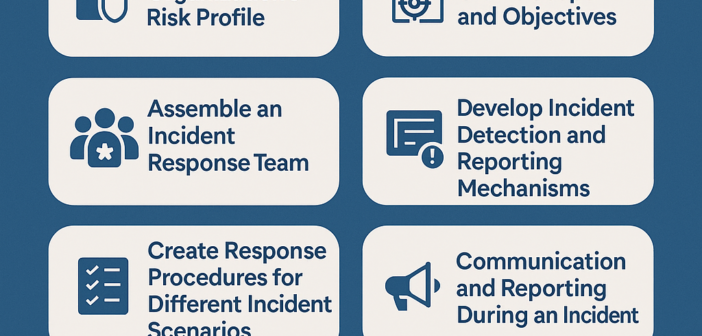In the modern digital age, businesses are increasingly vulnerable to cyberattacks. From ransomware to phishing attacks, the threat landscape is diverse and ever-evolving. As these cyber threats continue to grow, it’s critical for organizations to have a well-structured Cyber Incident Response Plan (CIRP) in place. A CIRP helps mitigate damage, reduce recovery time, and maintain business continuity during and after a cybersecurity incident.
This article will guide you through the process of building a robust Cyber Incident Response Plan (CIRP), including best practices, key components, and tips for ongoing optimization.
What is a Cyber Incident Response Plan (CIRP)?
A Cyber Incident Response Plan (CIRP) is a strategic document that outlines the actions to be taken when a cybersecurity incident occurs. The goal of a CIRP is to provide a clear framework for detecting, analyzing, containing, and mitigating cyber threats while ensuring minimal disruption to business operations. It ensures that all team members understand their roles and responsibilities during an incident and that the organization responds in a coordinated manner.
Importance of a CIRP
- Minimizes Damage: A CIRP helps limit the impact of an incident by guiding teams through containment and recovery processes swiftly.
- Reduces Recovery Time: Having a well-prepared plan can significantly reduce the time it takes to restore systems to normal.
- Maintains Business Continuity: By defining communication channels and processes, a CIRP ensures business operations continue even during an active incident.
- Compliance: Many industries require organizations to have an incident response plan in place to comply with data protection regulations, such as GDPR, HIPAA, and PCI-DSS.
- Reputation Protection: An effective CIRP shows stakeholders that your organization is proactive in managing cybersecurity risks, preserving trust and reputation.
Key Steps in Building a Cyber Incident Response Plan (CIRP)
Building a successful CIRP requires strategic planning and collaboration across different departments. Below are the key steps to creating an effective plan.
1. Understand Your Organization’s Risk Profile
Before you create a CIRP, it’s essential to understand your organization’s unique cybersecurity risks. Every business faces different threats based on its industry, size, infrastructure, and digital footprint.
- Identify Critical Assets: Determine which assets—data, systems, and applications—are most crucial to your operations. These are the targets you need to protect.
- Assess Vulnerabilities: Identify weaknesses in your network, software, and hardware that could be exploited by cybercriminals.
- Evaluate Potential Threats: Consider the specific types of threats (e.g., ransomware, DDoS attacks, insider threats) that could impact your organization.
2. Define the CIRP’s Scope and Objectives
A CIRP must be comprehensive and tailored to the specific needs of your organization. Define the scope of the plan, including:
- Incident Types: Decide which types of cyber incidents the plan will cover (e.g., data breaches, malware infections, denial of service).
- Incident Severity Levels: Establish different severity levels (e.g., low, medium, high) and describe how the response will vary depending on the level.
- Communication Protocols: Determine how internal and external communication will be handled during and after an incident.
3. Assemble an Incident Response Team
An incident response team (IRT) is a group of professionals responsible for managing cyber incidents. The IRT should include members from various departments, such as IT, legal, compliance, and public relations, depending on the scale and nature of the attack.
Key Roles in the Incident Response Team:
- Incident Response Manager: Oversees the entire response and ensures that procedures are followed.
- Technical Experts: Investigate and mitigate technical aspects of the incident (e.g., system administrators, cybersecurity specialists).
- Legal Counsel: Ensures that the response complies with legal requirements and industry regulations.
- Public Relations: Manages communication with external stakeholders, including the public and media.
- Forensics Team: Conducts a forensic investigation to understand the attack’s origin, impact, and extent.
4. Develop Incident Detection and Reporting Mechanisms
The faster an incident is detected, the quicker it can be contained and mitigated. To build a robust detection and reporting mechanism:
- Implement Monitoring Tools: Use Security Information and Event Management (SIEM) tools, intrusion detection systems (IDS), and threat intelligence platforms to monitor network traffic for suspicious activity.
- Set Up Reporting Channels: Establish clear channels for employees to report any cybersecurity incidents or suspicious activity.
- Conduct Regular Drills: Regularly test the detection capabilities of your security tools to ensure they are effective.
5. Create Response Procedures for Different Incident Scenarios
For each type of incident, create step-by-step response procedures. These procedures should be scalable based on the severity level of the incident.
Sample Response Procedures:
- Containment: Ensure that the incident is contained to prevent further damage. This may involve isolating affected systems or networks.
- Eradication: Once the incident is contained, remove any malicious software or compromised accounts from the environment.
- Recovery: Restore systems and data from backups. Ensure that any vulnerabilities exploited during the attack are patched.
- Post-Incident Review: Analyze the incident to understand what happened, what worked well, and what could be improved in future responses.
6. Communication and Reporting During an Incident
Effective communication is critical during a cyber incident. You must have clear protocols for internal and external communication.
- Internal Communication: Ensure that key personnel are informed and updated regularly throughout the incident.
- External Communication: Communicate with external stakeholders, including customers, partners, and regulatory authorities, as needed. Follow data breach notification laws and report incidents to the appropriate authorities if necessary.
- Public Communication: Develop a public-facing statement (if necessary) to keep customers and the public informed while protecting your organization’s reputation.
7. Conduct a Post-Incident Review and Continuous Improvement
Once the incident is over, conduct a thorough post-incident review to identify lessons learned. This review should assess:
- What went well and what didn’t?
- Was the response efficient and timely?
- Did the plan need adjustments based on the incident?
- What changes can be made to improve future responses?
8. Regularly Update and Test the CIRP
A Cyber Incident Response Plan is not a one-time project; it requires regular updates and testing. Cyber threats evolve, and so should your plan. Perform regular drills and simulations to ensure that your team is prepared for real-world incidents.
- Test the Plan: Conduct tabletop exercises and mock drills to simulate different types of cyber incidents and ensure that your team is prepared to handle them.
- Review and Update: Regularly update the CIRP to reflect changes in technology, business processes, and emerging cyber threats.
Best Practices for a Successful CIRP
- Document Everything: Keep a record of every step taken during the incident response process. This documentation will be crucial for compliance, legal purposes, and post-incident reviews.
- Involve Key Stakeholders Early: Ensure that the leadership team is involved in the planning process and understands their role during an incident.
- Train Regularly: Continuous training ensures that employees know how to spot potential threats and respond to incidents appropriately.
- Ensure Legal Compliance: Stay up to date with cybersecurity regulations and ensure that your CIRP complies with relevant laws and standards.
- Plan for Business Continuity: Your CIRP should work hand-in-hand with your business continuity and disaster recovery plans.
Conclusion
Building a robust Cyber Incident Response Plan (CIRP) is essential for any organization looking to protect itself against the growing threat of cyberattacks. By following the steps outlined in this guide—understanding your risk profile, defining response procedures, assembling an expert team, and continuously testing and improving your plan—you can ensure that your organization is prepared to handle cybersecurity incidents effectively.
A proactive approach to incident response not only helps protect sensitive data and systems but also builds trust with stakeholders, ensuring long-term business success. As cyber threats continue to evolve, keeping your CIRP up to date and conducting regular tests will ensure your organization is ready for anything the digital world throws at it.
References
- National Institute of Standards and Technology (NIST). (2018). Computer Security Incident Handling Guide (SP 800-61 Rev. 2). Retrieved from https://www.nist.gov/publications/computer-security-incident-handling-guide
- SANS Institute. (2020). The Importance of Incident Response Planning. Retrieved from https://www.sans.org
- European Union Agency for Cybersecurity (ENISA). (2021). Cyber Incident Response and Management. Retrieved from https://www.enisa.europa.eu
- ISO/IEC 27035. (2016). Information security incident management. Retrieved from https://www.iso.org
- Cybersecurity and Infrastructure Security Agency (CISA). (2022). Building a Cybersecurity Incident Response Plan. Retrieved from https://www.cisa.gov


